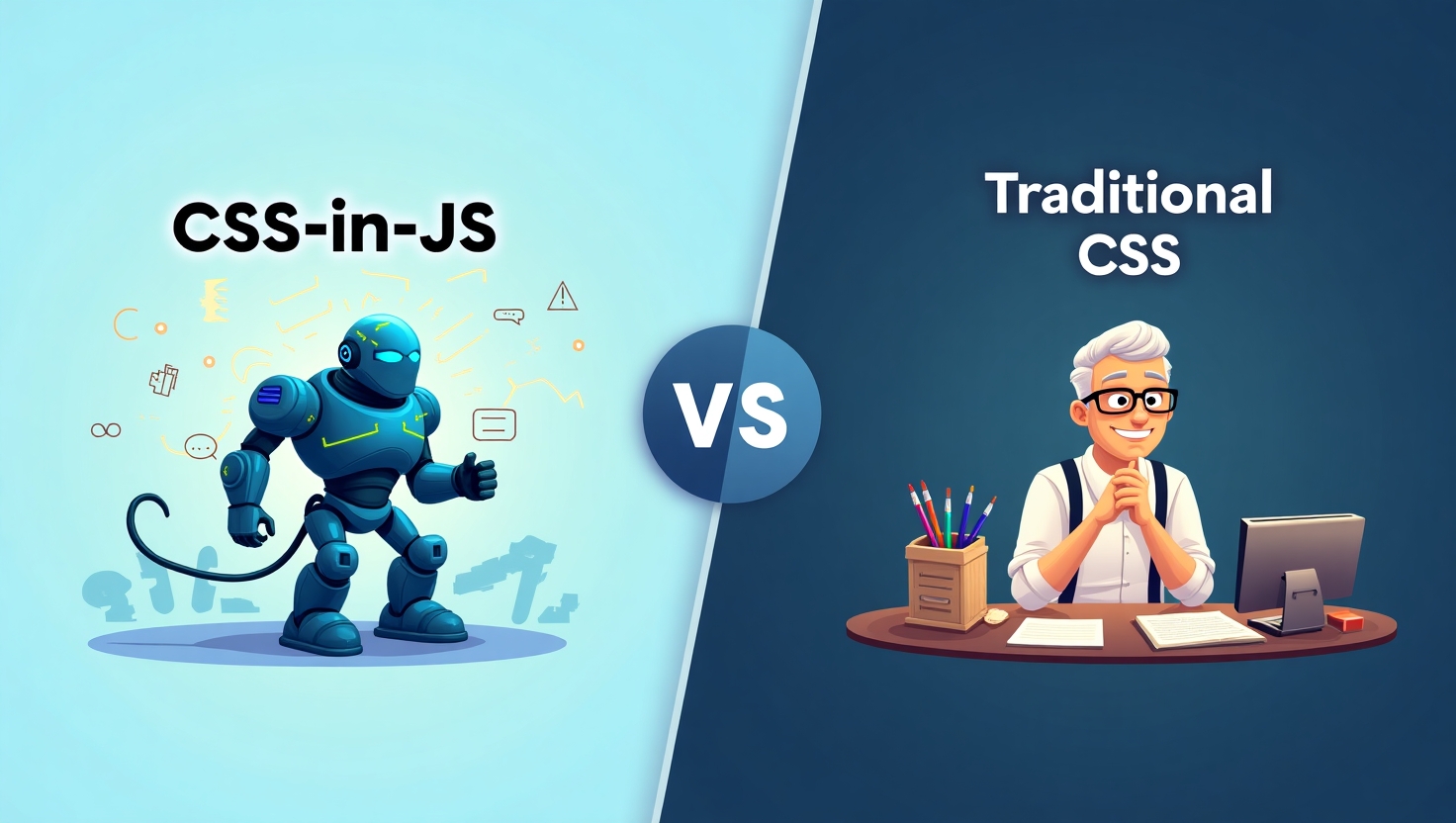1. Traditional CSS (with Preprocessors/Postprocessors)
Concept:
Traditional CSS involves writing styling rules in separate .css files. These files are then linked to the HTML documents to style the elements. Over time, this approach has evolved with the introduction of preprocessors like Sass and Less, which add features like variables, nesting, and mixins, and postprocessors like PostCSS, which allow for transformations and optimizations of CSS.
Key Characteristics:
- Separation of Concerns: Styles are kept separate from the HTML and JavaScript.
- Wide Browser Support: CSS is a fundamental language supported by all web browsers.
- Mature Ecosystem: Extensive tooling, frameworks, and best practices exist.
- Potential for Global Scope Issues: CSS rules can unintentionally affect other parts of the application if not managed carefully (e.g., through naming conventions like BEM or SMACSS).
- Build-time Processing: Preprocessors and postprocessors require a build step.
Pros:
- Clear Separation: Encourages a clear distinction between presentation and logic.
- Performance (Potentially): Browsers are highly optimized for rendering traditional CSS.
- Large Community and Resources: Abundant learning materials and community support.
Cons:
- Global Namespace: Can lead to naming collisions and specificity issues.
- Not Colocated with Components: Styles for a specific component are defined in a separate file, which can make it harder to manage for very modular applications.
- Dynamic Styling Challenges: Handling dynamic styles based on component state can be less straightforward.
Example (Traditional CSS):
.button {
background-color: blue;
color: white;
padding: 10px 20px;
border-radius: 5px;
}
.button:hover {
background-color: darkblue;
}
Example (with Sass):
$primary-color: blue;
$secondary-color: darkblue;
.button {
background-color: $primary-color;
color: white;
padding: 10px 20px;
border-radius: 5px;
&:hover {
background-color: $secondary-color;
}
}
2. CSS-in-JS
Concept:
CSS-in-JS is a technique where CSS styles are written directly within JavaScript code, typically within component files in modern JavaScript frameworks like React, Vue, or Angular. There are various libraries and approaches within CSS-in-JS, each with its own way of defining and applying styles.
Key Characteristics:
- Component Colocation: Styles are defined alongside the component's logic, making it easier to manage and reason about.
- Scoped Styles: Styles are typically scoped to the component, reducing the risk of global namespace collisions.
- Dynamic Styling: Easily apply styles based on component state or props.
- JavaScript Power in Styling: Leverage JavaScript logic within your styles.
- Runtime Styling (in some libraries): Styles might be generated and injected into the DOM at runtime.
- Build-time Extraction (in some libraries): Some CSS-in-JS solutions offer build-time extraction of CSS for better performance.
Pros:
- Improved Component Encapsulation: Styles are tightly coupled with the component.
- Easier Dynamic Styling: Seamlessly integrate JavaScript logic with styles.
- Avoids Naming Collisions: Styles are usually locally scoped.
- Automatic Vendor Prefixing (in some libraries).
- Dead Code Elimination (in some libraries): Only the styles used by the components are included in the final CSS.
Cons:
- Potential Performance Overhead: Runtime styling can sometimes have a performance impact (though many libraries optimize this).
- Increased Bundle Size (Potentially): Including styling logic in JavaScript can increase the bundle size.
- Learning Curve: Requires understanding the specific CSS-in-JS library being used.
- Separation of Concerns (Debatable): Some argue that mixing styling logic with JavaScript violates the separation of concerns principle.
Example (using Styled Components in React):
// MyButton.js
import React from 'react';
import styled from 'styled-components';
const StyledButton = styled.button`
background-color: blue;
color: white;
padding: 10px 20px;
border-radius: 5px;
&:hover {
background-color: darkblue;
}
`;
function MyButton(props) {
return <StyledButton>{props.children}</StyledButton>;
}
export default MyButton;
Example (using Inline Styles in React - more basic but illustrates the concept):
// MyOtherButton.js
import React from 'react';
function MyOtherButton(props) {
const buttonStyle = {
backgroundColor: 'green',
color: 'white',
padding: '10px 20px',
borderRadius: '5px',
};
return <button style={buttonStyle}>{props.children}</button>;
}
export default MyOtherButton;
Head-to-Head Comparison Table:
| Feature | Traditional CSS (with Pre/Post) | CSS-in-JS |
|---|---|---|
| Separation of Concerns | Clear (HTML, CSS, JS separate) | Can be debated (styles in JS) |
| Scope | Global (requires naming conventions) | Typically Local (component-scoped) |
| Dynamic Styling | Can be more complex | Generally easier and more direct |
| Performance | Potentially better browser rendering | Can have runtime overhead (optimized in many libs) |
| Bundle Size | Can be optimized with tooling | Can potentially increase (optimized in some libs) |
| Learning Curve | Familiar CSS syntax | Requires learning specific library API |
| Tooling/Ecosystem | Mature and extensive | Growing and evolving |
| Colocation | Styles in separate files | Styles alongside components |
Conclusion:
The choice between CSS-in-JS and Traditional CSS often comes down to the specific needs and context of your project.
- Choose Traditional CSS if you prefer a clear separation of concerns, are working on a project where performance of static styles is paramount, or are comfortable managing global styles with established methodologies.
- Choose CSS-in-JS if you prioritize component encapsulation, need seamless dynamic styling capabilities, are working within a component-based JavaScript framework, or appreciate the benefits of colocation.
Both approaches have their advantages and disadvantages, and the "best" choice is subjective and depends on your team's preferences and the specific requirements of your application. Stay tuned for the next Daily Comparison!
